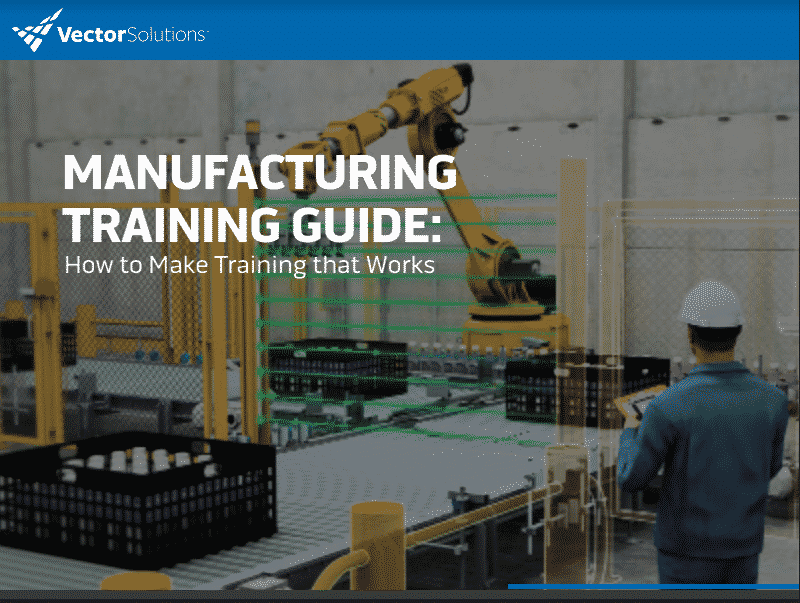December 31, 2015 19 min read
Onboarding New Employees: Why and How to Do It
Industry:
Solution:
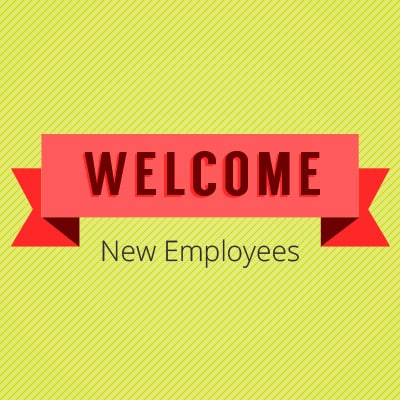
What do you do when a new employee is hired? Do you have a process for onboarding new employees?
Some organizations have no real plan for managing this process at all. Whatever happens, happens, and it varies from one new employee to the next based on a variety of circumstances.
Other organizations have some minimal preparations in place. The person gets a desk, computer, and phone, or the proper tools and safety equipment, and gets to fill out his or her benefit paperwork.
But high-performing organizations have a consistent, well-thought out new employee onboarding process in place. We’ll show you what that involves below. There’s even a checklist at the bottom for you.
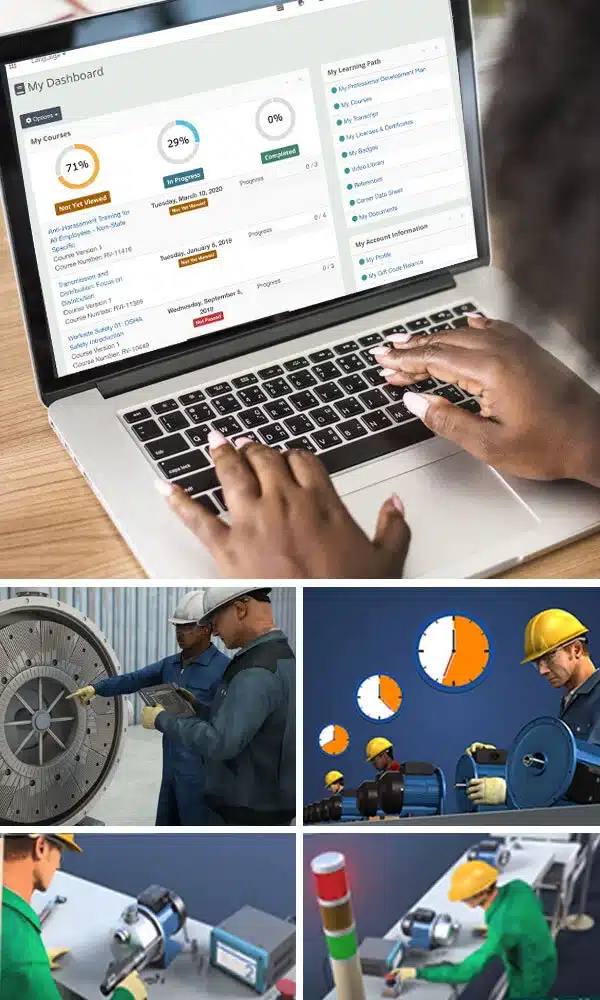
Vector EHS Management Software empowers organizations – from global leaders to local businesses – to improve workplace safety and comply with environmental, health, and safety regulations.
Learn more about how our software can save you valuable time and effort in recording, tracking, and analyzing your EHS activities.
Learn more about how we can help:
- Incident Management Software →
- EHS Inspection Software →
- Key Safety Metrics Dashboard →
- Learning Management System (LMS) and Online Training Courses →
- Mobile Risk Communication Platform
Download our EHS Management Software Buyer’s Guide.
What Is Onboarding?
According to a report by Booz Allen Hamilton prepared for the Partnership for Public Service, “Onboarding is the process of integrating and acculturating new employees into the organization and providing them with the tools, resources, and knowledge to become successful and productive.”
To get into a little more detail, onboarding is also a process that:
- Involves business leaders from many departments, not just HR
- Takes place over as much as a year, not just a day
- Is designed based on a set of specific objectives
- Involves many people in the organization, including people who play specific roles
- Is evaluated and measured to assure continuous improvement and positive outcomes
- Is delivered to all new employees
- Can be tailored for employees in specific job roles/positions/locations/etc.
We’ll look at this more comprehensively below, but that’s a starter.
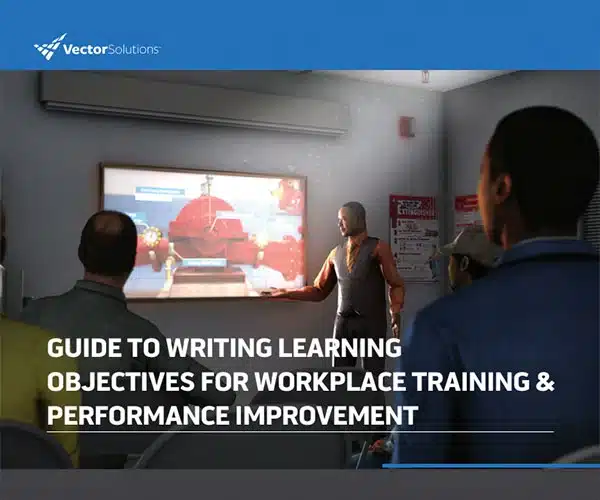
What Onboarding Is Not
Doing nothing to help a new hire is NOT onboarding. But you probably guessed that.
And doing a set of somewhat-random things for one new employee, and a different set of somewhat-random things for another new employee, based on circumstances, time, and your gut feeling, isn’t onboarding either.
In addition, people sometimes get confused and think that a one-day orientation process, often led by the HR department, is onboarding. That’s better than doing nothing, by far, but it still falls short of an onboarding program. Instead, the one-day orientation is part of a more robust onboarding process. You don’t want to throw out the baby (orientation) with the bathwater (onboarding), but you’ve got to pour a lot more water into that tub.
Why Should You Develop an Onboarding Program?
Onboarding programs that are well-designed and well-executed often have these benefits:
- Improves new employee performance
- Increases new employee engagement
- Increases employee retention
- Decreases the time after hire until new employee becomes fully productive
As you can see, these are strong benefits for both the onboarding company and the employee being onboarded. In short, onboarding is worth it.
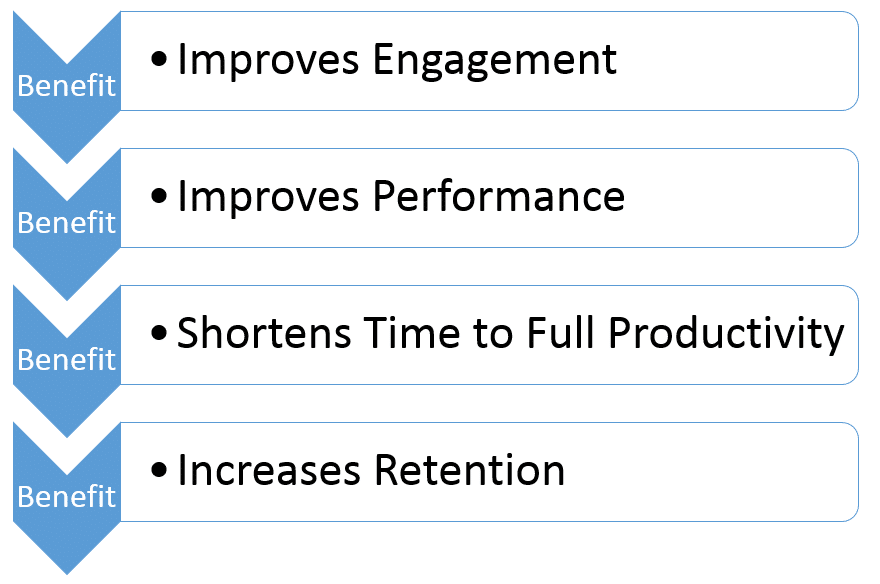
What An Onboarding Program Should Include
Your onboarding program for new employees should include specific:
- Objectives
- Roles
- Phases or stages, during which activities occur
- Measurements and evaluations
Let’s look at each of these four aspects more closely.
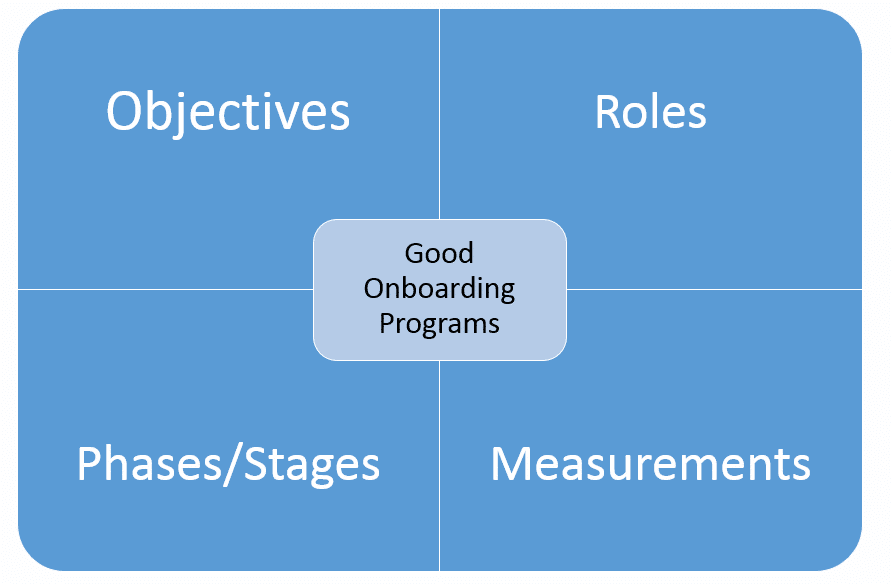
Objectives of an Onboarding Program
In general terms, your onboarding program should have the following goals or objectives:
- Help new employee learn the company’s mission, vision, strategic goals, and priorities
- Help new employee understand performance expectations for new job
- Help new employee reach those performance expectations
- Help the new employee understand, navigate, and comply with the company’s culture, expectations, organization structure, interpersonal relationships, and networking
- Make the new employee feel valued by the company and excited to work for the company
Keep these goals in mind while designing your onboarding program. Note that they may require you to do some research (what is our company’s mission?) and introspection (what is our company’s culture?).
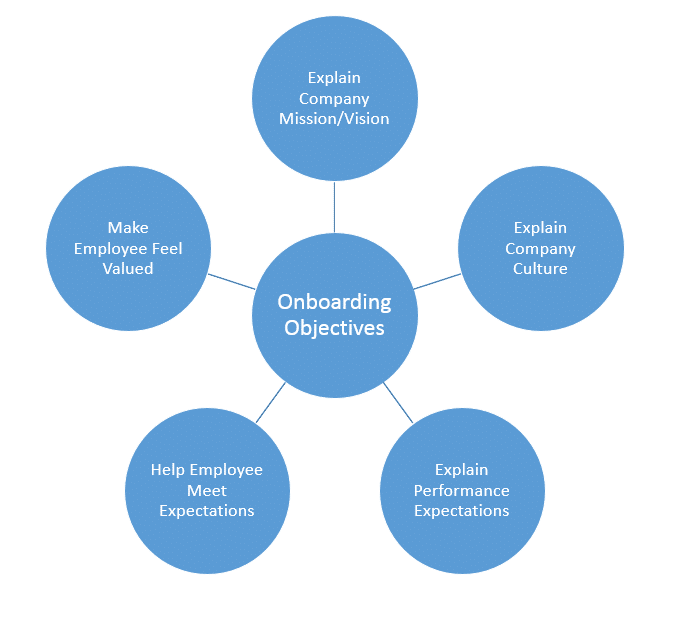
As an additional benefit, your onboarding program will help you learn more about your new employee, as well.
Roles in an Effective Onboarding Program
Different people at your workplace will play a role in the onboarding program.
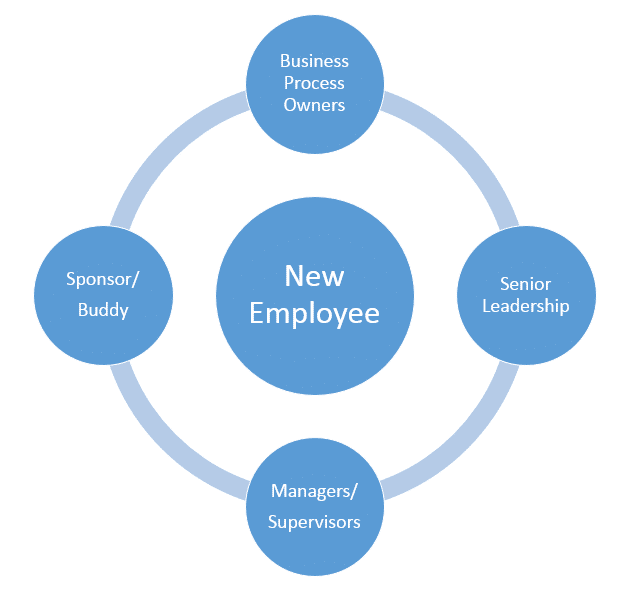
The roles are explained in more detail below.
Business Process Owners
HR will have paperwork for the new employee to sign, benefits to explain, and policies to go over. IT will have computers to set up. Facilities will have desks and chairs or other work equipment to put in place. Safety may have PPE to distribute. The Training Department will have training to deliver and performance support to supply. Leaders of other departments or work processes may be involved.
The efforts of all these people/departments should be coordinated, organized, and timely. Because there are multiple owners of this process, there’s a risk that nobody takes true ownership and accountability. That raises the chances of something going wrong.
One way to address this is to make sure the responsibilities of each business process owner is very clearly defined and communicated.
Another way is to consider appointing a single person with the overall responsibility and authority to make sure all the business process owners stay on task. You could think of that person as an “onboarding czar.”
Senior Leadership
It’s important that senior leadership play a role and make an effort to meet or otherwise communicate with the new employee (in large companies, that may happen through group meetings with new hire groups, videos, email communication, signed welcome letters, or similar means). For example, during the new employee’s first day, senior leadership should address and welcome them, explaining the history, mission, values, and strategic goals of the company. If it’s a smaller company, this can happen in person. If it’s a larger company, this can be via a live webinar or a recorded video.
Senior leadership may also make it a point to check back in with the new hire, maybe hosting a meeting or even lunch after 90 days and again after a year. It’s also nice to have an email, letter, or in-person visit from senior leadership to mark the new employee’s one-year anniversary.
Manager and/or Supervisor
The new employee’s manager and/or supervisor will play a large role in the onboarding process. This will include:
- Welcoming the new employee
- Meeting with new employee as soon as first-day orientation is complete
- Explaining the new employee’s job responsibilities
- Beginning to explain and set cultural expectations at work (how and when to communicate, what decisions the worker can make without manager approval, etc.)
- Explaining the company’s system for performance management and performance reviews
- Working with the employee to create a performance plan for the employee
- Assigning relevant training to the worker (possibly in concert with the Trainign department)
- Assigning meaningful, real work to the employee during the first week (and after, of course)
- Monitoring the new employee’s performance and offering helpful feedback throughout first day, month, year, and onward
Sponsor
This is a more experienced, successful worker in the same department or job role.
The sponsor should be a good employee, should have good people skills, and should be enthusiastic about playing this role. It’s also important to give the sponsor enough time to perform this role–don’t just dump another responsibility onto the person’s already busy schedule.
The sponsor can be the person the new employee goes to with common questions, such as “Where can I find this?” and “Who do I talk to about that?”
The sponsor can also help to explain to the new employee formal/written and informal/unwritten elements of the organization’s culture and expectations, help the new employee understand the organizational structure and internal politics better, introduce the new employee to personnel over time, and answer random questions.
New Employee
We’ve listed a lot of people doing stuff to help the new employee “fit in” and succeed at work. But onboarding is a two-way street, and the new employee has responsibilities, too. These include:
- Being engaged, attentive, and eager to learn
- Being open to new work processes, procedures, and styles and being prepared to adapt
- Completing required training
- Completing required paperwork
- Communicating clearly, effectively, and appropriately with business process owners, senior leadership, managers, supervisors, the sponsor, and other new coworkers
- Asking important questions
- Developing essential work relationships
- Finding and location resources and information needed at work
- Identifying knowledge, skills, and competencies necessary to succeed in his/her new position
- Acquiring the necessary knowledge, skills, and competencies
- Helping to develop his/her own career development plan
- Continuing to grow as a worker during the onboarding process (and beyond)
Five Phases of an Effective Onboarding Program
We’ve mentioned earlier that onboarding is more than just a one-day process and can take place during the entire first year.
You can break it down into a different number of stages or phases, with different activities occurring during each phase. We’ve chosen to break it down into five stages. The first stage begins after the employee is hired but before the first day on the job. The final stage ends at the worker’s one-year work anniversary.

Before the First Day
There’s no need for an employee to fill out all paperwork and/or learn about all benefits on the first day.
In fact, it’s probably better for everyone involved to get this started before the first day. That gives the new employee more time to learn and think about things, and makes it easier to consult with family or friends if necessary. It also means your staff can focus on collecting paperwork, answering outstanding questions, and getting the new worker moving forward more quickly instead of on clerical work.
Much of this can be done by mailing materials to the new hire, emailing materials, setting up some form of online web portal for hew hires, or a combination of all this.
Here are some things to think about sending/getting completed before the worker’s first day:
- Send the employee a welcome letter or welcome packet explaining how excited you are for the person to join your organization
- Send general information about your company (perhaps even your annual report)
- Send some information about the site the employee will work at, the department the employee will join, and the role the employee will fill
- Send HR and other legal/benefits-related paperwork and try to get it completed before the first day (or as much as possible)
- Have someone (HR, the person’s new manager, or both) contact the new employee and ask if he/she has any outstanding questions
- Select and assign a current employee to act as the new employee’s sponsor
- Have all business process owners complete necessary tasks to prepare for new employee’s arrival (phone, desk, computer, tools, work area, PPE, etc.)
The First Day (New Worker Orientation)
Many companies offer some form of first-day, new employee orientation program. That’s true even if the company doesn’t have a larger, more comprehensive onboarding program, and it’s certainly true of companies who do.
Here are some things to do/include during that orientation program:
- Personalize the experience for the individual and job role (as appropriate)
- Make the experience fun and active when possible
- Explain the organization’s mission, values, and strategic goals. This is a good opportunity for senior leadership to be involved–either in person or via video
- Link the new employee’s job role to the organization’s mission, values, and strategic goals
- Provide realistic, accurate information about the organization, its culture, and the person’s job role
- Introduce the new employee to his/her manager or supervisor
- Introduce the new employee to his/her sponsor
- Have someone with HR follow-up on any benefits issues, forms to be collected/signed, etc.
- Take the new employee on a tour of the work location
- Show the new employee where he/she will be working; ensure all necessary equipment is in place
- Introduce the new worker to other members of his/her team/department
- Show the new employee the “basics”–parking, entrance, restrooms, locker rooms, lunch room, coffee, water, etc.
- Provide some training to the worker. This is a good time to introduce the worker to your learning management system (LMS) at work.
- If possible, provide a meaningful work task to the worker
- Arrange to have senior leadership, the worker’s manager/supervisor, the sponsor, or other coworkers take the new employee to lunch
The Association for Talent Development (ATD) offers a helpful New Employee Orientation Training Workbook written by Karen Lawson with guides and activities for conducting a new worker orientation. The book is quite detailed and offers checklists, slides, activities and online resources, and gives tips for presenting the orientation in different lengths: two days, one day, and a half-day. If you’re looking for additional help with this phase, this book is a good start.
First Week
During the first week, keep integrating the new employee into the general workflow while continuing to address “new employee” issues and needs.
Here are some things to address during this time:
- Clearly communicate specific job responsibilities to new employee. This will probably be in the form of a discussion with the supervisor or manager. Answer any questions the employee may have.
- Continue introducing the new employee to his or her coworkers. The manager and/or the worker’s sponsor may play a large role here.
- Give the new employee some real, meaningful work to perform, if possible.
- Get the new employee a list of contacts for various needs.
- Have the employee offer feedback about the first-day new employee orientation program. This can be done in a discussion, paper-based survey, online survey, or other means. Use this information to continually review, evaluate, and improve your new employee orientation.
First Ninety Days
After the first week, the employee should begin the process of accepting additional work responsibilities and moving toward full productivity.
Here are some things to focus on during this phase:
- Have new employee complete any remaining “new employee” training
- Move new employee up to level of fully productive employee (or as close as possible)
- Begin providing training for advanced job skills/knowledge/needs
- Continue to monitor employee’s performance, provide regular and timely feedback, and answer questions
It’s not unusual for many companies to have hired a new employee on a temporary basis, with the 90-day point being the point at which the employee is let go or offered a permanent position.
First Year
Here’s what you can focus on after those first ninety days and during the remainder of the employee’s first year:
- Move out of “hand-holding” and “new employee-scaffolding” mode and move into a position of empowering the new employee to work efficiently and productively and provide increased value to the organization
- Provide necessary training to fill remaining knowledge/skill gaps and/or help the worker acquire necessary competencies
- Conduct a new employee survey at 3 months and again at 1 year, getting employee’s feedback on your onboarding program
- Observe and assess employee performance; provide regular feedback, compliments, and constructive criticism/guidance
- Conduct formal performance review at one year point
- Have senior leadership congratulate employee at one-year point (personal conversation, email, written letter, etc.)
Measurements of an Effective Onboarding Program
You should take and evaluate measurements on key performance indicators (KPIs) to see if your onboarding program is having a desired effect. Don’t simply assume it is, as you may be wrong.

But what should you measure?
Consider measuring and tracking things like:
- Percent of new employees with all paperwork completed before day one
- Percent of new employees with “all necessary supplies” in place by day one
- Reported employee satisfaction with new employee orientation (day one workshop)
- Reported employee satisfaction with new employee onboaring program (at 90 days and 1 year)
- New employee performance metrics (same as used for general employee performance evaluation)
- Attrition rate of new employees
If your KPIs are moving in the right direction, you’re making progress. If they’re not, go back to the drawing board and tweak some dials (to mix my metaphors).
Getting Started On Your New Employee Onboarding Program
Now that you know what a new employee onboarding program is, and you know about objectives, roles, phases, and measurement, let’s move on.
Here are some tips to keep in mind and use while developing you’re own onboarding program.
The Path to Success
Here are some general tips to keep you focused while developing or improving your current onboarding:
- Be comprehensive
- Start now
- It’s OK to start small
- Think of more than just the new employee orientation
- Identify key onboarding stakeholders; get their opinions, needs, and involvement
- Onboard all employees
- Use technology as appropriate
- Get feedback from onboarded employees (plus other stakeholders)
- Measure results of onboarding program
- Use measurements to continually improve onboarding program
What Are Your Goals?
More specifically, you’re going to want to keep the following goals in mind:
- Align the onboarding process to your company’s mission, vision, and goals
- Create a linkage between the onboarding program and your company’s culture
- Cleary define, communicate, and assign onboarding roles and responsibilities
- Help make workers more productive more quickly
Self-Assess: What Is Your Current State?
Do an organizational analysis and come up with a current baseline.
Analyze, understand, and document your current processes and measurements.
Assess:
- The scope of your onboarding. Who gets it and how long does it last? What does it cover?
- Your current onboarding approach. How are you doing it now? Who’s involved and who’s not? What technology is involved?
- The current program’s effectiveness. What are you doing well now? What are you doing poorly? What are you not doing at all?
How Can You Improve Quickly?
Some day, hopefully not too far in the future, you’ll have an excellent, comprehensive, exhaustive, world-class new employee onboarding program.
But until then, after you’ve assessed your current state and have identified some gaps, you can make some quick wins that will have a fast payoff without taking a lot of time or requiring a lot of work.
Some of these may include:
- Creating a “welcome” email or letter to be sent to new employees after they have been hired
- Creating an informational packet for the new employee
- Identifying sponsors for various departments
- Creating onboarding checklists for new employees
- Creating onboarding checklists for the managers and supervisors of new employees
- Making sure your orientation programs include information about the company’s mission, values, objectives, and history
- Getting senior leadership involved in orientation and in later onboarding activities
With these items and other quick wins addressed, you can turn your attention to more time-consuming, difficult, or problematic items.
Create Universal Onboarding First; Then Tailor For Specific Needs
Ideally, your onboarding program will really have several programs.
This will include one that will be universal for all employees. Get this one in place or moving forward first.
Next, you’ll have a series of more “tailored” onboarding programs for employees who are joining specific departments or filling specific job roles. The department-level managers or supervisors will have input in how to create these, and these may differ from department to department. Begin working with department heads and/or empower them to begin creating these. It may be helpful to create a general checklist of things for the department-level managers to consider/include.
Coordinate, Cooperate, and Communicate
Don’t have various stakeholders creating onboarding materials in silos. Get people together, make sure there’s a shared vision, communicate, and make resources available for copying/borrowing.
Using Technology
You don’t have to do all of this with paper, the mail service, and in-person discussions. Here are some tech tools that may prove helpful:
Online Onboarding Software Systems
There are companies that make products entirely dedicated to this process.
Online Form Completion
There are some forms that can be made available to new employees online. Then can then print and complete these forms, bringing them to work on the first day, or complete them online.
Online Web Portals
You can create your own Intranet web portals for new and current employees to access. These portals can be organized for ease of use and can include useful information that the employee can refer to–organization structure, contacts, mission statement, company rules and policies, benefit information, and more.
Video
You can use video (in many forms–recorded, webinar, etc.) to deliver information to your new employees. One example would be a recorded video of your CEO or another senior leader explaining the company mission, values, and objectives.
Learning Management Systems (LMS)
A learning management system (LMS) can help you create, assign, deliver, track, and report on the training aspects of onboarding.
Check our article on Using an LMS During Onboarding for more on this.
Mobile Apps and Devices
You can use mobile devices and apps during your onboarding. For example, you could have your coworkers “find” important work documents and contacts by using mapping information on a mobile device.
Social Networking Tools
Wikis, “traditional” social media networks like Facebook, Twitter, Pinterest, and LinkedIn, and similar tools made to facilitate inter-company communication (Jive, Yammer, etc.) may be helpful as well.
Checklists
Use this checklist to help walk you through the steps of onboarding a new employee. Modify this checklist as needed by adding, deleting, or changing items to fit your needs.
New Employee Onboarding Checklist
New Employee Name:
Job Role/Position:
Office/Cube/Work Area:
Hire Date:
Start Date:
Phone Number:
Email:
Complete these tasks before the employee’s first day on the job
- Send welcome letter and welcome packet to employee
- Provide information about the company and the job
- Send paperwork to new employee for completion (or make available on line)
- Have HR and/or new employee’s manager/supervisor contact new employee to address any questions
- Assign a sponsor to the new employee
- Assign and prepare office, cube, workspace, and all necessary supplies
Complete these tasks on employee’s first day of job
- Offer some personal gift/token to new employee
- Communicate company mission, vision, and objectives
- Explain benefits and policies to employee
- Have employee turn in or complete necessary paperwork
- Have senior leader of company greet new employee (perhaps explaining company history, mission, vision, objectives)
- Explain company culture to new employee
- Complete rest of new employee orientation session
- Take new employee out to lunch/provide lunch
- Introduce new employee to sponsor
- Have new employee perform meaningful work if possible
- Have new employee complete some basic training if possible
Complete these tasks during employee’s first week on job
- Communicate job roles and responsibilities to new employee
- Explain to employee how his/her performance will be evaluated, when, and by whom
- Introduce new employee to rest of department
- Introduce new employee to senior staff, other helpful contacts
- Review with employee organizational structure
- Provide employee with list of helpful contacts
- Gather feedback about new employee orientation (first day program)
Complete these tasks during employees’ first 90 days on the job
- Review performance objectives with employee
- Work with employee to set personal growth goals
- Give regular, frequent feedback to employee
- Provide basic training to employee as needed
- Discuss preferred work and communication styles
- Check with new employee often; address questions, provide guidance
Complete these tasks during employee’s first year
- Provide additional training to fill gaps in knowledge, skills, and to build competencies
- Conduct new employee survey to get opinions/thoughts on onboarding process
- Assess performance of employee at six months and again at year
- Send congratulatory email from senior leaders to employee
Conclusion: What Are Your Thoughts On New Employee Onboarding?
Let us know if you have tips of your own for successful onboarding, that’s what the Comments section below is for.
What do you do at your own workplace? What works well and what doesn’t? What did we say well above. What did we miss or say poorly?
How important do you think it is to onboard a new employee effectively?
Still curious about onboarding? Check out this interesting article on onboarding from the Harvard Business Review.
Until our next blog post, let us know if you need some workforce training, an LMS, or other custom training solutions.
And don’t forget to download the Guide to Effective Manufacturing Training below.
